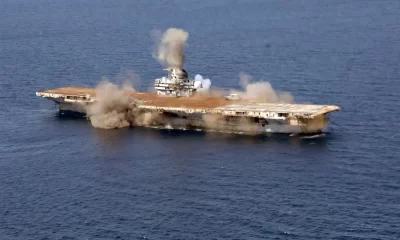Community
Hack Away The Inessential
Satirical wrecker turned caver Roger Williams waxes poetic on the techno-jetsam and detritus of a diving life well-lived. What does that dangling doohickey do again?? Find out.

by Roger Williams
Header image: The Williams’ shrine to the Dive Gods—where gear goes to afterlife. Note the forlorn ForceFin, jilted Jetfin and the SOS “Bendomatic.” All photos by Roger Williams.
My very first mask was an Oceanic Bi-Vu4. It didn’t just have side windows, it also had little prisms at the bottom of the front lenses through which it was supposed to be easier to see your chest and, thereby make it easier for you to find and manipulate anything you had clipped off there. The mask had the very best possible reviews from a well-known periodical and, because I didn’t know any better, that was good enough for me. I figured I’d done my due diligence and bought one for my open water (OW) class.
What actually happened was between the front lenses, the side lenses, the prisms, and the refraction from the water that kept filling the mask (because it didn’t fit worth a damn), I got to experience multi-imaged compound sight, which is the way many insects see the world. And this is why you have never, ever, seen nor heard of a Bi-Vu4.
I suffered through the use of that mask during my first dozen dives, until a kind shop owner handed me a simple two-lens and suggested I throw the Pink Floyd album cover in the trash.
Like most divers, I’ve got a whole bin full of old crap. The current bin is of the most storied, the most recent, or the most novel junk. This junk bin has been emptied many times over the years of snorkels and fins and tank bangers.

Retractors and coiled lanyards and knives the size of sabers and plastic gewgaws that seemed like they were a great idea at the time. Certain types of hoses and old regulators and reels with funky locking mechanisms. As much of a pack rat as I am, or as much as I hold the belief that I’ll find use for it someday, much of this stuff is eventually purged as the waste of space it almost all is.
Don’t know whatever happened to that mask, though.
I’m not just talking about having made the transition from 80s diver (80 feet deep, 80 foot viz, 80 degree water) to tech diver. Of course, as 80s divers, we all went through a phase of, “Will four different pockets on my BCD be enough?” and “Which dry snorkel comes in my favourite colour?” So having gone through THAT junk is to be expected of every single diver on the planet.
Slimming Down
I cut my teeth as a tech diver in the Northeast US. Without meaning to disparage many perfectly competent (and sometimes exceptional) divers, there is a certain commemorative pride in the Northeast of atypical behaviour or gear configurations. I suspect it is a long resonating holdover from the 80s and 90s when tech diving was still an inchoate technique and everyone was casting about for the “right” way of doing things [Oh, George? Inside joke!]. But for whatever the reason, the way I was originally mentored and trained to start venturing past traditional recreational limits was anything but traditional.
At least I was encouraged to get rid of my first BCD. It was a semi-tech-looking contrivance that was supposed to be good for single or double tanks, which is why I bought it in the first place. I figured from the start that IF I ever started using doubles I would be ready. But, as with the mask, I didn’t know squat. So what I wound up with was, as is frequently the case with tools designed to do two different things, a BCD that wasn’t terribly good at either of those things.
So I bought a backplate and wing (BP/W).
That it was a BP/W was about the only normal thing about it. I was never shown how to configure it properly, having figured it out from online “How To” guides. I was told (and presumed by watching everyone on the boat) that everything would be easier if there were d-rings all over the place.
The way I was shown to wear my stage bottles gives me a paroxysm of embarrassed winces. The way I was shown to switch to those stage bottles was non-existent. Everything about everything I did in those first years was just “good enough.”
The artefacts from that era in my diving career are still found not only in my junk bin, but also in various hardware bins. Huge D-rings fixed at various angles. Two-inch rings with a bolt snap the size of brass knuckles welded in. Speaking of brass, I probably have about enough of it still kicking around to restart the bronze age in double-ended bolt snaps alone. Carabiners and quick-links of a variety of sizes. I never actually owned a “slob-knob,” but I can’t say in all honesty that I never thought about it.

Basically: all manner of useless goddamn flotsam: stuff that, one by one, slowly but surely, continued to get stripped off of my harness or rigging and to find its way into the bin. Something like the chopper or bobber motorcycles of old (before “chopper” meant $150K custom jobby), if it was just aesthetic or served no practical function, off it came. If it wasn’t actually necessary for the completion of a dive, off it came. If it was a gimmicky solutionx to something that was already perfectly functional in a more ordinary configuration, off it came.
It took more than a decade and thousands of dives, as well as countless conversations with mentors and peers and students to finally, gropingly stumble into what should seem an obvious truth:
Simple, standardized, and streamlined is best.
This holds true for a variety of reasons.
As they say: safety first. No matter how often you might dive with the same buddy who knows (and maybe even matches) your screwball configuration, sooner or later you’re going to be diving with someone who has no bloody idea what they’re looking at on you. In an emergency, do you really want this stranger trying to figure out what you have clipped where and why? Or what the hell this thing is? Or what this regulator might be attached to?
Just as worrisome: what happens when you’ve made just one more change? Do you trust your own muscle memory to deal with the fact that now you’re running your alternate wing from your pony bottle that’s mounted pyramid style between your back mounted doubles? Or that if you can’t reach that pony-bottle knob in a place where it might roll off, you might as well not even have the tank.
There is a good handful of fatalities due to experienced technical divers using unfamiliar or unusual kit.
Safety In Streamlining

The safety in streamlining should be perfectly obvious, as well. It is hard to ignore the fact that if you’ve got all manner of protuberances sticking off of you at all angles and dangling from you as if you were some sort of neoprene-wrapped Christmas tree, you might as well just stay home and tie yourself to the couch with a tangled reel. There, at least, you can breathe.
And this is to say nothing of how much easier it is to move a streamlined rig through the water instead of flailing your way forward like an injured frogfish with acute heartburn.
And this is to say nothing of how much easier it is to move a streamlined rig through the water instead of flailing your way forward like an injured frogfish with acute heartburn.

“I like all the D-rings,” I’ve too often heard, usually from our 80s diver friends with the dozen plastic rings and pull tabs, “I wouldn’t have enough places to clip things off otherwise.”
I like to point out to these folks that I’ve done dives with as many as seven or eight tanks, two scooters, reels and lights and tools and backups of absolutely everything with exactly five D-rings. Only four if you account for the fact that one of them only ever has the primary scooter clipped to it. So it follows that if more crap is NOT better, less crap IS better.
“But when everything is clipped to its own D-ring it makes things easier to see and find. Learn better muscle memory.”
I know for folks who only dive a couple of times a year this can be a sore subject; but seriously, you’re going into a potentially dangerous situation in what is objectively a hostile environment. Be prepared for that.
“I like air integration, I can just look at my computer.”
“Well what happens if your transmitter craps out or the signal is interrupted?”
“I still have an SPG.”
“So you have an expensive extra thing which is giving you information you should actually already know, that you might have to resort to the analog thing you’ve already got?”
I suppose the argument could be made that it’s a redundant monitoring system… but I think we both know you’d have to squint real hard to make that argument convincing, much less valid. The truth is you just wanted it and could afford it; it’s neat, but sorta pointless. Chop it.
“I like a pull tab that dumps air from my wing over here instead of over here.”
“I like wearing ankle weights because it keeps my feet down.”
“I like having a chest strap that holds my whatever against my whatever.”
“I like having my regulators hooked up backwards because that’s the way my instructor said is better.”
“I like using quick disconnects for everything so I can hook anything to anything else.”
“I like tying this bungee around myself because it keeps everything tight.”

“I like wearing my drysuit inside out because then it’s easier to find leaks.”
OK, I made that last one up. But how many times have you heard people excusing the daffiest goddamn shite and all you can do is shrug because you’d rather just go diving than stand about having a debate?
For my part, for many years, I’ve been using atypical regulators. I’ve liked a great many things about them; I’m used to them to the point I strongly prefer them. Not the least of the things I’ve liked about them is “I have them.” I started accumulating a horde of them while I was still in New Jersey where they were very much in vogue.
Recently, however, I’ve been dragging myself, reluctantly, to the conclusion that their unconventional nature is outside of what I should consider acceptable. This culminated when, just a few days ago, I was asked by someone I’d been diving with for weeks, “Where is the purge button on this?”
It was like a gutshot. I’d thought I’d told them at some point… but whether I had or not was irrelevant. Because in an emergency it would have been unfair and potentially fatal to expect someone who needed a breath RIGHT NOW to remember, “Oh, right, Rog said the purge was over here somewhere.”
In the fullness of time, all these regs, too, will be finding their way one by one into the junk bin. I obviously don’t think that they are de facto deadly; who knows how many safe dives have been made using these exact things over decades? But into the junk bin they will still, inevitably, go.
Simple, Standardized, And Streamlined Is Best.
There are some groups and clubs and agencies and cliques which may take the standardization thing to a weird, logical conclusion. Who would demand that something atypical be thrown onto a ceremonial pyre at once! Some folks go so far as to start inventing non-standard equipment, plunging themselves down a rabbit-hole in the pursuit of standardization. I am not much of a joiner myself and, therefore, am not suggesting here that there is only one right and true way of doing any of this scuba stuff.
Other manufacturers legitimately do make some odd odds and ends that, at least, can make inconsequential tasks a hair easier. At most, these can drive innovation and create market and industry movements toward something better which may very well become the standard.
The fact of the matter is that the vast majority of the hundreds of thousands of dives that happen every year all over the world are made by 80s divers who probably have every variety of crap clipped off to their dozen plastic D-rings and are hand-finning around like a drunken eagle ray as their split-fins dangle uselessly beneath them. And they’re going to get back on the boat just fine. We don’t all have to look exactly the same and all carry our spare mask in the same pocket; there are limits where it all starts going a little overboard.
But how much more comfortable would those vacation divers be if someone told them not to get split fins in the first place? And if someone had shown them how to correctly configure a backplate and wing and shown them how to balance themselves?
How much less would people struggle personally and as a team if they were trained on similar equipment that is configured safely and simply? Ergo: enjoying their precious bottom time much, much more. And, in the event of an incident, be far better prepared to either anticipate, avoid, or deal with the effects without having to get bailed out by an underpaid divemaster.

How much more comfortable would I have been if, when I tried to buy that marginal mask, the checkout page on the website just said, “NO! YOU’RE NOT ALLOWED TO HAVE THIS. IT’S A PIECE OF S***. PICK SOMETHING BETTER.” Same goes for that old BCD. Or all that stainless steel. Or the 30+ regs that now need replacement. How much emptier would my junk bin have been over the years if I’d had more people along the way to drive home the message:
Simple, standardized, and streamlined is best.
Yeah, there are different environments. The scenery here of the Mexican caves is very different from the shipwrecks off Long Island. But whether you want to admit it or not, the only practical difference in the water needs to be thermal protection and having an SMB in your pocket.
And dramamine. A lot of dramamine.
For more information you can visit:
www.XOC-Ha.com
www.facebook.com/xochabnb
https://www.instagram.com/xochabnb/

Roger Williams isn’t interested in many things that aren’t dive-related. Even non-technical-dive-related is on shaky ground. He first discovered tech diving while living in his native New Jersey and used to be an ardent diver of the NY/NJ wrecks. He used to tell people that it was the best place in the world to dive for years while working as a full-time instructor in Hawaii. But that was a long time ago; before he found his heart in the caves.
For some years he was the Dive Safety Officer for the WCS New York Aquarium in Brooklyn. Currently (and for the foreseeable future) he and his wife, Nelly, own and operate XOC-Ha, a divers’ BnB near Akumal, in the heart of Mexico’s cave country. Roger teaches cave, technical, and CCR diving while Nelly creates sorcery in the kitchen for their guests. If you see him staring off into space and ask, “What are you thinking?” he’d probably say, “Safety, balance, stability, and team problem solving.” And you would be perfectly within your right to say, “About dinner! I meant what are you thinking about ordering for dinner!”





















































